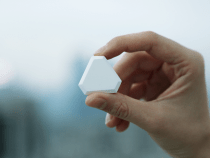
Movement tracking could get a whole lot more granular if the New York-based startup behind this wearable sensor gets its way. Notch, currently being shown off in prototype form on Kickstarter, is a wearable sensor designed to be concealed within clothing at natural hinge points around the body to track and capture specific body movements – sending that data back to a companion (iOS) app for tracking and review.
Right now, there’s no shortage of wearable tech aimed at fitness and activity use-cases, whether it’s Fitbit or Jawbone’s UP or Nike’s Fuelband to name a few. Easily enough activity tracker bangles to fill the average-sized forearm. And that’s before you get started on smartwatches. But fewer Bluetooth sensor-makers are aiming to capture precise body movements – likely because on the surface it seems a smaller, more niche use-case. Something for dancers, athletes and freerunners to get excited about, perhaps.
But then again, a wearable sensor – or more accurately a network of sensors if you want to capture a whole concert of body movements using Notch – that can record precise, physical movements and deliver localised feedback to an arm or leg, has potential to be useful in a variety of ways. As a warning system against slouching when sitting, perhaps (a la the LUMOback). Or a stress monitor, based on how much nervous gesticulating you’re doing at work.
Notch is designed to both capture movement data (either continuously or on demand – recording and pausing can be controlled by tapping on an individual sensor), and to output haptic feedback, via tiny vibration motors, meaning it can be used for motion-triggered notifications. The sensors use inertial measurement units to capture body motion, and Bluetooth Low Energy to send recorded data to the Notch app.
For starters, Notch’s own app will offer the ability to set up the individual mobiles, record movements, collect data on those movements, replay the movements as 3D visualisations, and download the data in XYZ format, say its makers. But they are also planning to release an API to allow third party developers to build out additional use-cases for Notch. So if they can excite enough developers, they could end up with some pretty off the wall motion trigger-tech scenarios.
Each Notch sensor is 1.3

0 Responses
Stay in touch with the conversation, subscribe to the RSS feed for comments on this post.